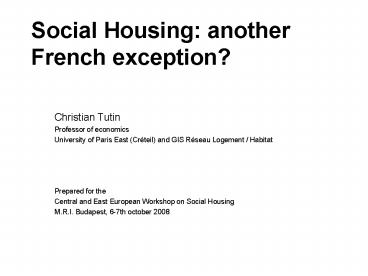Social Housing: another French exception - PowerPoint PPT Presentation
1 / 21
Title:
Social Housing: another French exception
Description:
University of Paris East (Cr teil) and GIS R seau Logement / Habitat ... In a dubitative way : the limits of decentralised procedures; lord-maires do not ... – PowerPoint PPT presentation
Number of Views:21
Avg rating:3.0/5.0
Title: Social Housing: another French exception
1
Social Housing another French exception?
- Christian Tutin
- Professor of economics
- University of Paris East (Créteil) and GIS Réseau
Logement / Habitat - Prepared for the
- Central and East European Workshop on Social
Housing - M.R.I. Budapest, 6-7th october 2008
2
I Housing tenures and public delivery the
European diversity
- Social housing in Europe
- 22.5 millions housing units
- 10.5 of the total stock
- High degree of diversity
- - from 34 in NL (155/1,000 inhabitants)
- - to near zero (GR, EST)
- - France 18 (70/1,000 inhabitants)
3
Where is normality ? Over 15 ? Between
5 and 10 ? Below 5 ?
4
- Not only the weight of social housing (absolute
or relative), but the combination of tenures - Three patterns special cases
- Mainstream AUS, CZ, DK, FI, FR, SW PL
(?) - - Moderate rate of owner-occupation
- - Strong social housing sector (gt12,5)
- - Non-residual private rental sector
- Mediterranean BUL, EST, GR, IT, PG, SP
LUX BE - - Invasive owner-occupation
- Inexistant social sector
- Residual private rental sector (? BE IT)
5
Eastern HU, LIT, RO, SL, SV IRL -
Dominant home ownership - Residual social
housing sector - Representing a significant
part of the total rental sector Special cases
NL, UK, GE
6
- North-western mainstream group NL UK
- 17 millions units of social housing
- 77 of EUs social housing stock
7
The relative weight of SH is inversely correlated
with national wealth
8
2. How much exceptionnal is the French way ?
- Access to social housing a generalist model
(as in Austria) a lot of countries more
restrictive, but some more opened (DK, SW). - Rent-fixing a cost-based system, like in most
other countries. - Ownership and control
- Shared between 2 groups of registered social
landlords - Public Offices (owned by local authorities)
- Social firms for housing (non
profit-maximising companies) - Offices ESH the so-called HLM sector (3,9
millions units)
9
- Plus non registered social land-lords
- So-called mixed companies (SEM), where local
authorities are associated with private capital
0,6 million units - And another 0.3 million units directly owned by
municipalities, the State or public firms. - As in many other European countries, the
decision-making has been more and more
decentralised in the last 2 decades - Building permits in 1982
- Distribution of loans and other state aids in
2004.
10
Main specificities
- The relative weight of private rental housing
- Housing types and location
- - High proportion of flats in multi-units
buildings - - High degree of spatial concentration
- Subsidies and funding
- - Direct (mainly below market interest rates)
and indirect (fiscal) subsidies - - A specific financial circuit for social
housing, with - A special savings booklet ( Livret A ) whose
deposits are centralised and transformed by a
public financial institution (the Caisse des
Dépôts et Consignations CDC) - outstanding deposits 125 billions
- annual loans for the HLM sector 6 billions
- An employers contribution to housing (the
so-called 1 logement ) - - More recently (2004), a massive urban renewal
program
11
3. General trends in Europe towards
residualisation ?
- 3.1 The UK containment , rather than
residualisation - Dualist or polarized
- Despite massive privatisations since 1981 (2.2
millions units sold to tenants in UK), the
British social stock remains the largest one in
Europe (4.9 millions units in 2006 more than 5
millions until 2003), - representing the same proportion of the stock as
in France
12
(No Transcript)
13
- Really residual
- - Germany,
- - Ireland,
- - Eastern European countries (Hungary, )
14
3-2 The Netherlands stabilisation
15
3-3 France continous growth or smooth decline ?
- No decline of the social stock, either absolute
or relative - (on the contrary, slow but steady growth)
- Decline as a proportion of new constructions
(from 24 to 16 between the 70s and 90s), but
more than compensated by purchases, and higher
demolitions in the private sector (till
recently).
16
(No Transcript)
17
(No Transcript)
18
Current debates and new trends
- Social housing under attack
- Doesnt house those it should
- Too much middle-class household (in fact, no more
than 15) - Not housing the poorest (persisting homelesness)
- On-going changes
- Reform in finance
- Privatisations (objective of 40 000 sales yearly)
- Future law (to be discussed in Parliament next
week) will change rent regulation and security of
tenure
19
Conclusions
- The French case is not so special
- Surprisingly, France is very close from main
stream North-Western European countries - What lessons from the French experience ?
- - In a positive sense, the kind of funding
system (use of private guaranted saved by a
powerfull public financial institution) - - In a negative sense, attention must be paid to
the factors explaining the suburb crisis
(physical design of buildings, excess of
multi-family homes, obsolescence of big estates,
spatial concentration) - - In a dubitative way the limits of
decentralised procedures lord-maires do not want
very social housing may be only the state, in
partnership with civil society actors, can
address homelesness
20
(No Transcript)
21
(No Transcript)































